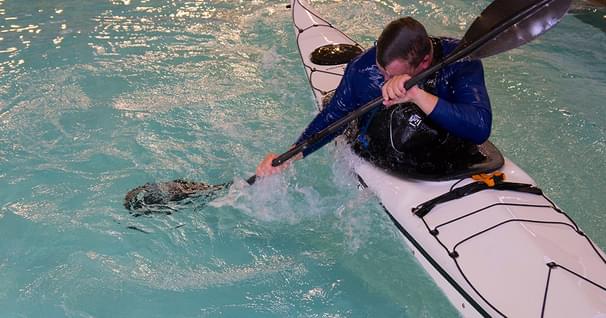River Signals
By Tim Sprinkle
Whitewater rivers are, by their very nature, chaotic and confusing places. Mixing bowls of water and rock that challenge paddlers to not only keep themselves upright, but also find the best line to safety and enjoy themselves in the process. This also makes boater-to-boater communication, a crucial part of safe paddling, a very difficult task. Even in this age of advanced communication technology, whitewater paddlers need a simple way to keep in contact with each other out on the river.
That's why, back when the sport was still an obscure niche, the paddling community established a set of basic visual signals to facilitate on-water communication. These signals have since been adopted by American Whitewater (AW), the country's largest whitewater boaters' association, and codified as their "Universal River Signals" – clear, easy-to-understand tools that today are used by boaters all over the world. They are designed with simplicity in mind: simple to execute, simple to understand; everything you need to control a paddling group on the water.
What can these AW signals do for the average boater? Keep them safe, for starters. Without an understanding of the tools of the trade, river scouts and group leaders can't guide others away from obstacles, and paddlers in trouble can't signal for help. On the water, they are a life link between individual boaters.
The universal signals can all be shown either empty-handed (especially useful when you've lost your grip and need to stop the group) or with a paddle in hand. They are designed for high-visibility on the river, so always be sure to extend them as far over your head as possible so everyone can see. And, as with most backcountry communication, once you see a signal pass it on so paddlers behind will get the message.
50 years of lightweight, maneuverable, high-performing kayaks.
Check out this interview with Tom Keane, Eddyline Kayaks Co-Owner, on their journey!
Stop: raise your paddle overhead, parallel to the water, and pump it up and down. This can also be done by holding your arms out to your sides to form a "T" and waving them up and down slightly. The "all stop" signal is best used by a leader or scout to control a group of boaters and warn them about a potential hazard ahead. According to AW, after the stop signal is shown, other paddlers should "wait for ‘all clear' before proceeding."
All clear: raise your paddle blade (or a single finger) directly overhead, perpendicular to the water. For better visibility, AW suggests turning the paddle blade flat to increase the surface area. Use the "all clear" to restart progress after a stop, or to direct the rest of your party to a preferred course (the best line through a rapid, for example, or around an obstacle). "Lower the previously vertical ‘all clear' by 45 degrees toward the side of the river with the preferred route," they say. "Never point toward the obstacle you wish to avoid." (Make sure everyone in the group understands this before you hit the water.)
Help/emergency: To signal distress on the water, you can either hold your paddle vertically and wave it back and forth; or do the same with a helmet, PFD, or a hand. If you have a whistle available, give "three long blasts" while waving to be sure you attract attention. The emergency signal, understandably, isn't set in stone, but as long as you signal with three whistle blasts and a wave you should be understood.
OK: repeatedly pat the top of your head to let the rest of the group know that you're OK and ready to continue on.
These visual signals are designed to help paddlers stay in contact on the water and be safe when working their way through rapids. Keep in mind, however, that personal responsibility is still the key to safe paddling. Solid communication skills may help you out of a lot of sticky situations, but they are no substitute for knowing your limits and brushing up on those fundamental paddling skills.
Tim Sprinkle writes and paddles around his home in central Virginia. His work has appeared in Seakayaker, Paddler, and a number of other publications.
Related Articles
As the days get shorter and the weather gets colder, it becomes harder to get out and paddle and easier…
Mention “pool session” and the first image that pops into most kayakers minds is a class in how to roll.…
Paddling alone is a recipe for danger. Bring a buddy and stay safe on the water.




